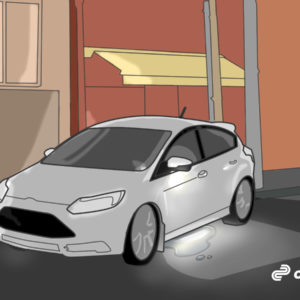One of the perks of being a car owner is you get to beat the heat while traveling. However, there are cases when the air conditioner (A/C) is on, but the cabin remains warm, even after having your A/C recharged.
This is an issue more often found in older vehicles. So if your ride falls under that category, make sure its A/C is always charged.
CAUTION: Always wear gloves and eye protection when working with refrigerant. Don’t ever do A/C work on anybody else’s car unless you’re certified to work with refrigerants.
How Long Does an A/C Recharge Last?
Most A/C recharge lasts three to five years, depending on the frequency you use your car’s A/C.
Note, however, that even when you use your defroster, the A/C system is activated to dry the air. Modern A/C systems since about 2000 have been tighter and less leak-prone than older vehicles. It’s not unusual to see a vehicle that has never needed a refrigerant recharge and is still doing just fine even though the vehicle may be 20 years old.
What Is an A/C Recharge?
Car air conditioner recharge is the process of adding more refrigerants. Refrigerants, by default, have a very low boiling point so that, as they evaporate, they absorb heat, which is the principle that makes an A/C system blow cold. When the refrigerant level is low, the A/C doesn’t work; even if it does, it might work okay in the evening yet not blow cold on a hot day.

Is It Normal for a Car to Lose Refrigerant?
Even a well-maintained vehicle can lose refrigerant over time, and it’s completely normal. This is usually the case with older vehicles. With newer vehicles, however, they tend to hold less refrigerant in their systems.
Most vehicles can hold up to 32 ounces of refrigerant, which can take some time to run out and cause problems for your A/C system.
But if you think that your vehicle is losing refrigerant at an alarming rate, you might be dealing with a leak that needs immediate attention.
How Do I Know if My Car A/C Needs to Be Recharged?
Your car A/C will give off symptoms that the refrigerant level is low and the A/C needs to be recharged. What you may notice first if the refrigerant level is low is that the A/C doesn’t cool well in the heat of the day but may work fairly well at night. Some foreign cars may cool well on the passenger side but not on the driver’s side.
Lacks Cooling Capabilities
Again, the most telltale sign your car needs its A/C recharged is if it begins to blow warm air. Keep in mind this can happen for other reasons besides low refrigerant, such as issues with the A/C clutch circuit, the clutch air gap, heater blend door malfunction, etc.
Refrigerant Leaks
Refrigerant leaks can be very difficult to find, particularly if they’re slow leaks. Most of the time you won’t find it unless you get lucky or it’s in an easy to spot place.
If you notice wet, oily spots around any A/C component or either charge port, they might be refrigerant leaks. The compressor is a very common leak point. A leak in the condenser or evaporator may be very difficult for you to locate. Shops use special methods to find leaks like these.
CAUTION: Inhaling refrigerants can lead to severe health problems. As such, be careful when handling leaks, and make sure to refill the refrigerant after.
A/C Clutch Not Engaging
The clicking sound you hear when you turn the A/C on comes from the A/C clutch on your compressor engaging. Some clutches rely on the pressure of the system to engage. Low or high refrigerant levels can cause issues that prevent the compressor clutch from engaging.
Low refrigerant will typically cause the A/C compressor to “short cycle,” meaning, it’ll turn off and on very frequently. Also, if the A/C clutch air gap gets wide enough, this can cause the A/C compressor not to re-engage after it cycles off normally. The gap is adjustable by a professional.
Low refrigerant will typically cause the A/C compressor to “short cycle,” meaning, it’ll turn off and on very frequently.
– Richard McCuistian, ASE Certified Master Automobile Technician
How Often Does a Car A/C Need to Be Recharged?
Some experts recommend having your car A/C recharged every two years.
Other experts, however, do not necessarily agree with this. They might advise you that if your A/C is working okay, just don’t worry about it. Paying for a recharge when you aren’t having issues is wasting money, and it can be very expensive. You do, however, need to have your cabin air filter checked and replaced every year if your vehicle is equipped with one.
How Much Does Car A/C Recharge Cost?
The average cost of recharging your car’s A/C ranges from $150 to $300. You can also replenish it yourself to save money, as recharge kits typically cost $50 to $100.
Note: putting too much refrigerant in a system can cause problems with the A/C cooling as well.
Can I Recharge the A/C Myself?
Yes, you can recharge the car A/C yourself, granted you have a recharge kit and the appropriate tools and know-how. But if you’re not sure how to do it, it’s best to leave the task to experts, as slight missteps could cause more issues.
What Does an A/C Recharge Entail?

While recharging the A/C is a simple process, it could get complex depending on what mechanics find while doing it. It usually involves the following:
Identifying the Refrigerant
Mechanics would identify the type of refrigerant that the car uses to ensure they refill it with the right one. Refrigerants are volatile, so mixing different kinds can lead to adverse reactions that can damage the A/C system.
Removing the Refrigerant Oil
Mechanics must add the right amount of lubricating refrigerant oil into the system to protect the A/C compressor. To determine the right amount, they remove any refrigerant oil from the refrigerant and transfer it into a container for measuring.
Repairing or Replacing Bad Parts
After refrigerant removal, mechanics will address the issues in the A/C system. They might have to repair or replace parts, depending on what they find.
Evacuating the System
Mechanics will start evacuating the system or ensuring it’s moisture-free. They use a vacuum to boil the trapped moisture, leaving behind water vapors that a vacuum pump removes from the system and releases into the atmosphere.

Evacuating the system helps keep air from entering the refrigerant line and causing system failure.
Replenishing the Refrigerant
Finally, the mechanics will replenish the refrigerant. Most vehicles have a sticker or placard that shows the right amount of refrigerant to use.
Wrapping Up
Recharging your A/C is crucial, especially if you want to stay cool while driving on hot days. Make sure to recharge it every two years to prevent problems and save money from costly repairs.
Where to Find Dependable A/C Components for Your Vehicle
Damaged A/C parts can take the fun out of driving your vehicle. So when it’s time to shop for high-quality air conditioning products, look no further than CarParts.com. We have a great selection of A/C system parts that are guaranteed to last long.
Sourced from the most trusted aftermarket brands today, our products pass strict quality checks to ensure maximum durability and dependability.
Find the right parts for your ride by entering your vehicle’s specifications into our vehicle selector. For a more personalized shopping experience, use the search filters to narrow down the catalog according to your preferred brand, price range, quantity, and more.
Enjoy the best prices when you shop from us. All our products come with a low-price guarantee, helping you get the best value for your money.
Check out our products today!
Any information provided on this Website is for informational purposes only and is not intended to replace consultation with a professional mechanic. The accuracy and timeliness of the information may change from the time of publication.
































